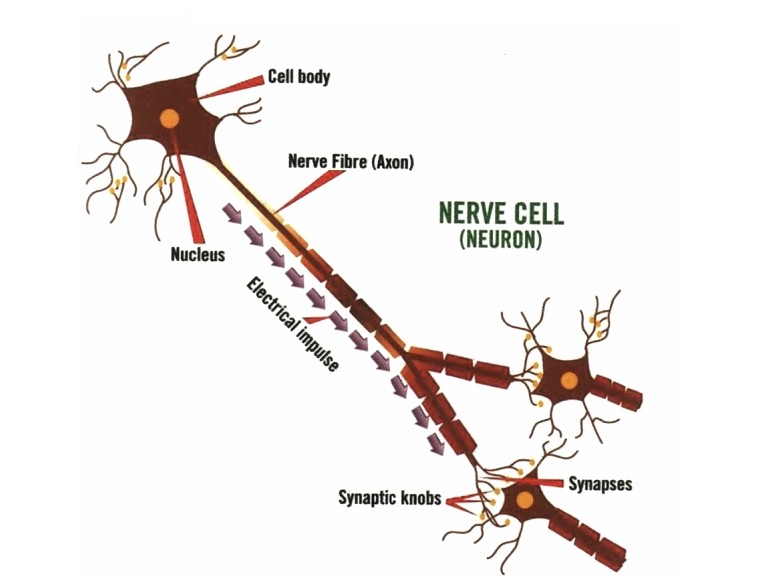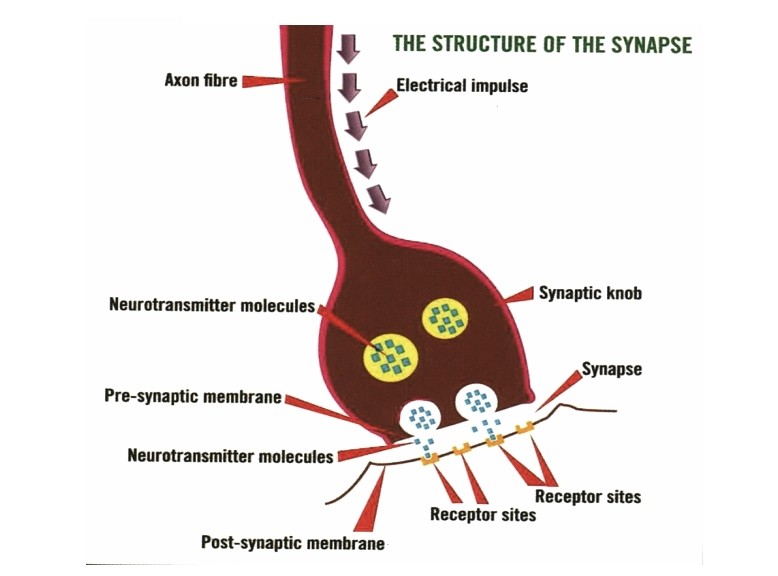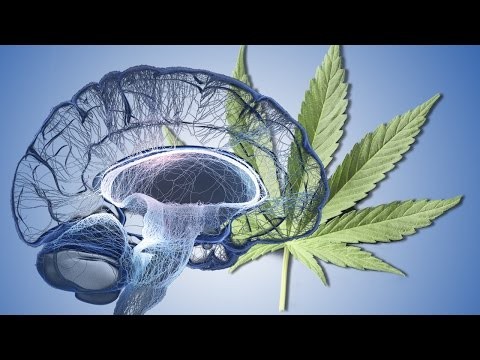By Mary Brett BSc (Hons) Chair of Cannabis Skunk Sense in Great Britain www.cannabisskunksense.co.uk
Damage is caused in several different ways.

BRAIN: Messages are passed from cell to cell (neurons) in the brain by chemicals called neurotransmitters which fit by shape into their own receptor sites on specific cells.
The neurotransmitter, anandamide, an endo-cannabinoid (made in body) whose job is to control by suppression the levels of other neurotransmitters is mimicked and so replaced by a cannabinoid (not made in body) in cannabis called THC (Tetrahydrocannabinol). THC is very much stronger and damps down more forcefully the release of other neurotransmitters. Consequently the total activity of the brain decreases. Chaos ensues.
Neurotransmitters delivering messages to the hippocampus, the area for learning and memory don’t receive enough stimulation to reach it, so signals are lost for ever. Academic performance plummets and IQs fall by about 8 points. Neurons can be lost permanently. This is brain damage. No child using cannabis even occasionally will achieve their full potential.
Because signalling is slowed down, reaction times increase. Driving becomes hazardous and fatal accidents are rising in legalised USA states. Alcohol plus cannabis in drivers is 16 times more dangerous.
Since THC is fat-soluble, it stays in cells for weeks, constantly ensuring this decrease in brain activity. In the sixties/seventies the THC content was around 1-3%, now in London only ‘skunk’ at 16-20% THC is available. Professor Sir Robin Murray has said that, ‘users will be in a state of low-grade intoxication most of the time’.

The Dopamine neurotransmitter has no receptor sites for anandamide and so THC doesn’t affect it. But the inhibitory Gaba neurotransmitter has. Gaba normally suppresses dopamine but since it is itself suppressed by THC, levels of dopamine quickly increase. Excess dopamine is found in the brains of psychotics, and even schizophrenics if they have a genetic vulnerability. Anyone taking enough THC at one sitting will suffer a psychotic episode which could become permanent.
Aggression, violence, even homicides, suicides and murders have resulted from cannabis-induced psychosis. The first research paper linking THC with psychosis was published in 1845. Cannabis-induced schizophrenia costs the country around £2 billion/year. Some of these mentally ill people will spend the rest of their lives in psychiatric units.
THC also depletes the levels of the ‘happiness’ neurotransmitter Serotonin. This can cause depression which may lead to suicide.
THC causes dependence. This will affect 1 in 6 using adolescents and 1 in 9 of the general population. Since THC replaces anandamide, there is no need for its production which reduces and eventually stops so the receptor sites are left empty. Withdrawal then sets in with irritability, sleeplessness, anxiety, depression, even violence until anandamide production resumes. Rehab specialists have told us that adolescent pot addiction is the most challenging to treat.
Cannabis can also act as a gateway drug – it can ‘prime’ the brain for the use of other drugs. Professor David Fergusson (NZ) in longitudinal studies from birth found that ‘The use of cannabis in late adolescence and early adulthood emerged as the strongest risk factor for later involvement in other illicit drug use’.
THC inhibits the vomiting reflex. If a person has drunk too much alcohol, they are often sick and get rid of it. An overdose of alcohol can kill (respiratory muscles stop working) so using cannabis together with alcohol can be fatal.
The signalling of endo-cannabinoids is crucial in brain development. They guide the formation, survival, proliferation, motility and differentiation of new neurons. THC badly interferes with these essential processes.
Chaos ensues among the confused brain signals and a cannabis personality develops. Users can’t think logically. They have fixed opinions and answers, can’t find words, can’t take criticism – it’s always someone else’s fault, and can’t plan their day. Families suffer from their violent mood swings – houses get trashed. Anxiety, panic and paranoia may ensue. At the same time users are lonely, miserable and feel misunderstood.
Respiratory System:
Cannabis smoke has many of the same constituents as tobacco smoke but more of its carcinogens – in cancer terms a joint equals 4/5 cigarettes. More tar is deposited in the lungs and airways. Coughing, wheezing, emphysema, bronchitis and cancers have been seen in the lungs.
Heart:
Heart rates rise and stay high for 3-4 hours after a joint. Heart attacks and strokes have been recorded. Some teenagers had strokes and died after bingeing on cannabis.
Hypothalamus:
The hypothalamus is a region of the brain known to regulate appetite. Endo-cannabinoids in this area send ‘I’m hungry’ messages. When you take THC, that message is boosted. This is called ‘the munchies’. Nabilone, (synthetic THC) can be used to stimulate the appetite in AIDS patients.
DNA and Reproduction:
THC affects the DNA in any new cells being made in the body. It speeds up the programmed cell death (apoptosis) of our defence white blood cells, so our immune system is diminished. There are also fewer sperm. Infertility and impotence have been reported as far back as the 1990s.
An Australian paper published in July 2016 explains this phenomenon. THC can disrupt the actual process of normal cell division mitosis and meiosis (formation of sperm and eggs). In mitosis, the chromosomes replicate and gather together at the centre of the cell. Protein strands (microtubules) are formed from the ends of the cell to pull half of the chromosomes to each end to form the 2 new cells. Unfortunately THC disrupts microtubule formation. Chromosomes can become isolated, rejoin other bits of chromosome and have other abnormalities. Some will actually be shattered into fragments (chromothripsis).
This DNA damage can also cause cancers. Oncogenes (cancer-causing genes) may be activated, and tumour suppressant genes silenced. Chromosome fragments and abnormal chromosomes are frequently seen in cancerous tissues. This would account for other cancers, leukaemia, brain, prostate, cervix, testes and bladder etc, reported in regions of the body not exposed to the smoke. Pregnant users see a 2-4 fold increase in the number of childhood cancers in their offspring.
The DNA damage has also been associated with foetal abnormalities – low birth weight, pre-term birth, spontaneous miscarriage, spina bifida, anencephaly (absence of brain parts), gastroschisis (babies born with intestines outside the body) cardiac defects and shorter limbs. All these defects bear in common an arrest of cell growth and cell migration at critical development stages consistent with the inhibition of mitosis noted with cannabis.
DNA damage at meiosis results in fewer sperm as we have seen. Increased errors in meiosis have the potential for transmission to subsequent generations. The zygote (fertilised egg) death rate rises by 50% after the first division.
In infants, birth weight is lower and they may be born addicted. Children may have problems with behaviour and cognitive functions as they grow. Childhood cancers are more common. Intensive care for newborns doubles. The younger they start using cannabis, the more likely they are to remain immature, become addicted, suffer from mental illnesses or progress to other drugs. Average age of first use is 13.
Regular cannabis users have worse jobs, less than average money, downward social mobility, relationship problems and antisocial behaviour.
References:
Cannabis Skunk Website www.cannabisskunksense.co.uk Cannabis: A survey of its harmful effects by Mary Brett is available on DOWNLOADS. It is a 300+ page report written in 2006 and kept up to date.
Chromothripsis and epigenomics complete causality criteria for cannabis- and addiction-connected carcinogenicity, congenital toxicity and heritable genotoxicity https://www.cannabisskunksense.co.uk/uploads/site-files/ty,Chromothripsis,CarcinogenicityandFetotoxicity,MR-FMMM.pdf
Book: Adverse Health Consequencies of Cannabis Use. Jan Ramstrom National Institute of Public Health Sweden www.fhi.se

